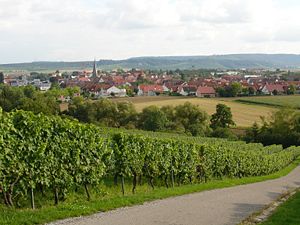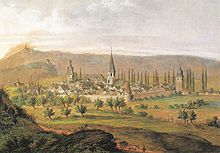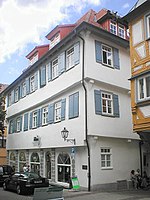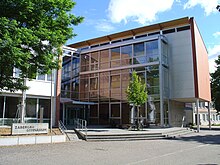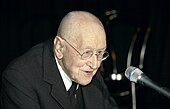Brackenheim
| coat of arms | Germany map | |
|---|---|---|
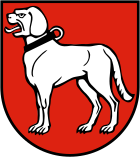
|
Coordinates: 49 ° 5 ' N , 9 ° 4' E |
|
| Basic data | ||
| State : | Baden-Württemberg | |
| Administrative region : | Stuttgart | |
| County : | Heilbronn | |
| Height : | 192 m above sea level NHN | |
| Area : | 45.75 km 2 | |
| Residents: | 16,106 (Dec. 31, 2018) | |
| Population density : | 352 inhabitants per km 2 | |
| Postal code : | 74336 | |
| Area code : | 07135 | |
| License plate : | HN | |
| Community key : | 08 1 25 013 | |
| LOCODE : | DE BCM | |
| City structure: | 8 districts | |
City administration address : |
Marktplatz 1 74336 Brackenheim |
|
| Website : | ||
| Mayor : | Thomas Csaszar (independent) | |
| Location of the city of Brackenheim in the Heilbronn district | ||
Brackenheim ( ) is a town in the Heilbronn district in Baden-Württemberg . It belongs to the Heilbronn-Franconia region (until May 20, 2003 Franconia region ) and the peripheral zone of the European metropolitan region of Stuttgart . With a total vineyard area of 798 hectares , it is the largest wine-growing community in Württemberg . One of the city's most famous sons is the first German Federal President Theodor Heuss .
geography
Geographical location
Brackenheim is located on the Zaber in the Zabergäu in the southwestern district of Heilbronn, 15 km southwest of the independent city of Heilbronn . With its districts, Brackenheim reaches the slopes of the Heuchelberg in the north and touches the foothills of the Stromberg mountain range in the south . The landscape is characterized by the intensive viticulture.
Neighboring communities
Neighboring cities and communities of Brackenheim are ( clockwise , starting in the southwest): Cleebronn , Güglingen , Eppingen , Schwaigern , Nordheim , Lauffen am Neckar (all districts of Heilbronn), Kirchheim am Neckar and Bönnigheim (both districts of Ludwigsburg ). Brackenheim has entered into an agreed administrative partnership with Cleebronn .
City structure
Brackenheim consists of a total of eight districts, in addition to Brackenheim itself from Botenheim , Dürrenzimmern , Haberschlacht , Hausen an der Zaber , Meimsheim , Neipperg and Stockheim .
The residential areas Burgermühle and St.-Johannis-Mühle belong to Brackenheim itself , to Meimsheim the residential areas Bellevue, Obere Schellenmühle and Untere Schellenmühle, to Neipperg Castle and Hof Neipperg , to Stockheim Castle and Hof Stocksberg. Lost and no longer existing places are the stallion mill on the Botenheim mark and the Jägerhaus, grinding mill and starch factory on the Meimsheim mark.
Division of space

According to data from the State Statistical Office , as of 2014.
history
Until the 18th century
The area between the Stromberg and the Heuchelberg has been populated for around 5000 to 6000 years. The oldest human settlement finds in the area of today's city of Brackenheim date from the Neolithic Age , from which about 30 settlement sites in the city area are proven. A settlement of the urban area extending along and north of the Zaber is also documented from the following epochs, which was traversed by numerous prehistoric paths that had an important junction in and around today's Meimsheim district .
At the time of the Romans, Brackenheim was in the hinterland of the Neckar-Odenwald-Limes or Upper German-Raetian Limes . At that time there were numerous Roman manors in the fertile Zabergäu . The most important finds from Roman times in today's urban area were recovered from the Martinskirche in Meimsheim and in Hausen an der Zaber . From the following time of the Alamanni there are only a few and sometimes controversial finds from Brackenheim. The intensive settlement of today's urban area and the founding of today's districts then took place during the Frankish conquest from the 6th century. The Meimsheim district was mentioned for the first time in 788 in the Lorsch Codex , followed in 793/94 by Botenheim and Frauenzimmern or Dürrenzimmern .
A Zeisolf von Brackenheim was mentioned in the 12th century in the Hirsauer Codex on the occasion of a donation of goods in Botenheim and Meimsheim. The place Brackenheim is mentioned for the first time in a document by Erkinger von Magenheim from October 6, 1246. The Lords of Magenheim are a verifiable aristocratic family since 1147 at the latest with extensive possessions in Kraichgau and Zabergäu and with ties to the Diocese of Mainz , Diocese of Speyer , Diocese of Worms , the Hohenstaufen and also to King Rudolf I of Habsburg. The expansion of the town of Brackenheim to a town goes back to the Magenheimers, who may already have had a seat in an old castle proven by the name of the castle . The existing site was expanded as planned and walled in almost rectangular. In addition, a new mansion was built within the city, to which today's castle goes back. The oldest mention of it as an oppidum (city) dates back to 1279, and Rudolf I formally granted city rights on May 29, 1280. With the first mention of the market gate in the direction of Neipperg in 1301, the completion of the walling of the city is considered proven. Until the early 20th century, the city barely grew beyond this medieval enclosure.
By dividing the estate, the Magenheimer property was divided into different parts. To 1280 received it Erkinger III. from Magenheim the city of Brackenheim with accessories. After 1287, his sons divided the property again. Half of Brackenheim came through further inheritance to Count Burkhard von Hohenberg, who sold his property in Brackenheim, Magenheim and Blankenhorn Castle to Count Eberhard I of Württemberg in 1321 . His son Ulrich III. sold the property in Brackenheim to Archbishop Matthias von Mainz in 1327, but Württemberg regained possession of that half of the city around 1356. In fact, Württemberg seems to have ruled the entire city from that time on, as Eberhard II acquired the claim to the remaining half of the city for a very small sum from four Magenheim heirs on December 27, 1367.
Brackenheim became the official city of Württemberg. In addition to the city, the Brackenheim office originally included the towns of Haberschlacht , Meimsheim , Nordheim , Hausen an der Zaber , Dürrenzimmern and the Württemberg half of Cleebronn . The communities of Kleingartach , Niederhofen and Stetten am Heuchelberg were added later.
The Brackenheim Castle , together with the city and the Office Brackenheim different widows württembergischer regent as widow seat prescribed, it also served as a residence of the Württemberg Upper Vogts. In the 17th and 18th centuries, however, none of the widows who received the castle actually lived in Brackenheim.
During the Thirty Years' War , Brackenheim had to endure multiple looting and the effects of troops moving through and billeting. The greatest need had just been overcome when, from 1688 onwards, with the outbreak of the Palatinate War of Succession , military operations around Brackenheim took place again. In the midst of this time of need with looting and the devastation of fields, a major fire occurred in May 1691, in which 112 buildings in Brackenheim were destroyed. The fact that the residents of the surrounding districts had stored their furniture and their fruit supplies in the supposedly safer city, dramatically increased the extent of the disaster. There was famine and poverty, which were exacerbated by acts of war and bad harvests in the years that followed.
After the city fire of 1691, large parts of the north and east of the city were destroyed, with reconstruction continuing well into the 18th century. A redesign of the market square was necessary. The old town hall from 1424 was also burned down, so that the council moved into the former bathhouse until the new town hall was completed on the site of the old one in 1776.
19th to 21st century
With the establishment of the Kingdom of Württemberg in 1806, Brackenheim remained the administrative seat of the Oberamt of the same name (from 1934 Brackenheim district). During the administrative reform in Württemberg during the Nazi era , Brackenheim came to the Heilbronn district in 1938. In 1933 there were 1633 inhabitants, in 1939 there were 1671.
In the last days of World War II , Brackenheim was the target of several bombs on April 2 and 5, 1945, covering numerous roofs and severely damaging some buildings, especially barns. Although anti-tank barriers were erected and two bridges were blown up on April 5 and 6, French troops entered Brackenheim on the afternoon of April 6, 1945 without a fight, after which there were occasional looting and rape. The war damage had largely been repaired in late 1945. In 1946, around 550 displaced persons, mostly from the Sudetenland, were accepted into Brackenheim.
In 1945 the place became part of the American zone of occupation and thus belonged to the newly founded state of Württemberg-Baden , which was incorporated into the current state of Baden-Württemberg in 1952.
As part of the Baden-Württemberg community reform, the neighboring communities of Botenheim, Dürrenzimmern, Haberschlacht, Hausen an der Zaber, Meimsheim, Neipperg and Stockheim were incorporated into Brackenheim from 1971 to 1974. The lively designation of building areas let the districts grow together and led to a significant increase in population, from 1995 to 2004 alone by almost 2,700 inhabitants.
Incorporations
| district | date |
|---|---|
| Messenger home | 1st January 1971 |
| Drought rooms | 1st November 1971 |
| Haberschlacht | February 29, 1972 |
| Meimsheim | April 1, 1972 |
| Neipperg | 1st January 1974 |
| Stockheim | 1st January 1974 |
| Hausen on the Zaber | 1st October 1974 |
Religions
Denomination statistics
According to the 2011 census , 53.5% of the population in 2011 were predominantly Protestant , 18.6% Roman Catholic and 27.9% were non-denominational , belonged to another religious community or did not provide any information. As of June 30, 2019, of the 16,363 inhabitants, 2,731 (16.7%) are Roman Catholic, 7,398 (45.2%) Protestant and 6,234 (38.1%) are non-denominational or belong to another religious community. The number of Protestants and Catholics has therefore decreased in the observed period.
history
Brackenheim has been predominantly evangelical since the Reformation. The city is the seat of the Brackenheim church district of the Evangelical Church in Württemberg . In Brackenheim, Botenheim, Dürrenzimmern, Hausen, Meimsheim and Neipperg there are Protestant parishes of their own; Haberschlacht and Stockheim share a common parish. Brackenheim is also the seat of the Protestant district youth organization Brackenheim, which is part of the Protestant youth organization in Württemberg and is responsible for youth work in the parishes of the church district Brackenheim.
In Stockheim there is the Catholic parish of St. Ulrich, which also includes Haberschlacht and the Eppinger district of Kleingartach. Neipperg belongs to the parish of St. Martinus in Schwaigern. The Catholic Christ the King Congregation in Brackenheim was essentially created by the influx of Catholic expellees after the Second World War and includes the rest of the Brackenheim districts.
An Evangelical Free Church congregation (Baptists) and Jehovah's Witnesses are also represented in Brackenheim, the Methodist Church in Botenheim and the New Apostolic Church in Meimsheim .
politics
Local council and local councils
After the municipal council election on May 26, 2019, the municipal council has 22 seats due to the abolition of the fake local election. Another member of the council and its chairman is the mayor.
| Party / list | Share of votes | Seats |
|---|---|---|
| CDU | 25.5% | 6th |
| FWB | 27.2% | 6th |
| List 21 | 18.8% | 4th |
| SPD | 14.3% | 3 |
| Alliance 90 / The Greens | 14.1% | 3 |
After the local elections on May 25, 2014 , the Brackenheims council has 30 seats (previously 29). The election result was as follows:
| Party / list | Share of votes | + / - | Seats | + / - |
|---|---|---|---|---|
| CDU | 33.6% | - 3.6 | 10 | - 1 |
| SPD | 15.9% | - 3.5 | 5 | ± 0 |
| The left | 2.0% | + 2.0 | 1 | + 1 |
| FWB | 27.5% | - 1.9 | 8th | - 1 |
| List 21 | 21.0% | + 7.0 | 6th | + 2 |
| total | 100% | 30th | ||
| Turnout: 49.5% (- 2.4) | ||||
After the local government reform in 1974 there were local councils and honorary local councilors in some of the Brackenheim districts , but not in others. In order to achieve an equal treatment of all districts as far as possible, the Brackenheim municipal council asked the local councils in a resolution of January 29, 2004 to dissolve by 2008 in favor of so-called discussion groups , as they already existed in the other suburbs. The last local council in Haberschlacht dissolved in 2009.
There are now so-called discussion groups in all districts and in the core city. These discussion groups, which bring together "all decision-makers on site [...] such as the local councils from the district, representatives of the churches and associations, the local agenda, the schools, the volunteer fire brigade or the partnership committee", should serve to "make important decisions and To discuss matters of the respective districts and to exchange ideas. "
On July 3, 2014, the majority of the members of the municipal council decided to revise the main statute of the city of Brackenheim and thus to repeal the bogus local election from the next election of the municipal council in Brackenheim in 2019. The future number of seats for the members of the municipal council will be set at 22 from 2019.
mayor
- 1988–2020: Rolf Kieser
- since 2020: Thomas Csaszar
badges and flags
The blazon of the Brackenheim coat of arms reads: In red a standing silver bracke with a black collar and a silver guide ring. The city colors are white and red.
Brackenheim's oldest surviving seal from 1301 already shows the standing Bracken as a talking coat of arms . The dog has been used in various positions over the centuries - standing, striding, jumping, etc. - and since the 16th century with various additions such as a collar or chain. The colors have always remained the same and probably go back to the Lords of Magenheim , who temporarily owned Brackenheim as a Mainz fief . In 1953, the Brackenheim municipal council established the coat of arms in its current form based on the oldest city seal.
Town twinning
As early as 1962, today's Neipperg district entered into a partnership with the French municipality of Marsan in Gascogne ( Département Gers ). In 1978 Brackenheim entered into a partnership with the French town of Charnay-lès-Mâcon in the Saône-et-Loire department , which was expanded in 1996 to include the Italian municipality of Castagnole delle Lanze in Piedmont ( Asti province ). A friendship treaty was signed in 2001 with the Polish community of Zbrosławice in Upper Silesia . Friendly relationships at club level are also maintained with Le Lude in France and with Port Talbot in Wales .
In 2000 Brackenheim is in recognition of the use of the city for the European idea of the euro Europe with the European Diploma was awarded. The partnership committee of the city of Brackenheim takes care of maintaining friendly and cooperative relationships.
Culture and sights
The association Kulturforum Brackenheim e. V. has had its own venue with 200 seats in the form of the chapel in the castle since 1994, which is used for concerts, cabaret and theater guest performances.
Museums
The municipal Theodor-Heuss-Museum in Obertorstrasse, established in 2000, is dedicated to the life of Theodor Heuss , the city's great son. As early as 1968 there was a Theodor Heuss memorial at the same location.
The Heimatmuseum of the Heimatverein Brackenheim in the district of Botenheim shows local history exhibits.
Buildings
- The Protestant town church of St. Jakobus goes back to a former Jakobus chapel, which was expanded in the Gothic style and elevated to a town church in the early 16th century.
- The Protestant St. John's Church in the Brackenheim cemetery is the original Brackenheim parish church. In this late Romanesque basilica with a high Gothic choir, wall paintings from the 13th and 14th centuries as well as numerous historical tombs have been preserved. After the Second World War, the church was also used for services by the Catholic community, before the Catholic community built its own church in 1954, the Christ the King Church .
- The Brackenheim castle in the south of the old town was from 1556 to 1559 as a city palace instead of the old castle of the Lords of gastric home under Duke Christoph von Württemberg built by architect Martin Berwart. The three-winged building served as a widow's residence in Württemberg. After a fire in 1670, the west wing and the north transverse wing were rebuilt from 1677 to 1685 by master builder Weiss, which essentially gave the castle its present shape. Later the building was the apartment of the governor and the official residence. Currently only the district court is housed in the castle.
- The Obertorhaus was a senior official prison from 1828 to 1907, and the Theodor Heuss Memorial has been located in the building since 1968, and reopened in August 2000 as the Theodor Heuss Museum . Opposite the Obertorhaus was the house where Theodor Heuss was born, which in 1950/51 had to give way to the construction of the wine growers' cooperative, which was operated until 1975 and is now used as the city archive. A memorial stone now commemorates this building.
- The town hall is a Rococo style building built in 1774 . It stands on the site of a previous building built in 1424 and was extensively renovated in 1954.
- The New Bath was initially a beguinage from 1400 to 1530, was converted into a municipal bath in 1576, after the fire of 1691 it served as the town hall until 1776 and has been a commercial building since then. A blacksmith's shop and dye works were temporarily located here.
- The Oberamts building housed the Oberamt Brackenheim until 1800. After that it was used as a residential and commercial building, for a long time as a bakery.
- The old school near the town church was built in 1608/10 and was a Latin school until 1804, then a school building until 1896. The ornate half-timbered house, which is connected to the former predicature , is now an office building.
- The Protestant Diakoniehaus was built in 1706. The Protestant deanery building was built in 1749 and used until 1977.
- Numerous other historical half-timbered buildings have been preserved in Brackenheim's old town. Outstanding are the Pfründnerhaus from 1461, the building from 1580 in the Rosengasse and the inn "Ochsen" with an ornate Renaissance portal. Renovated in 1993 Bandhaus the castle winery was built in 1600 and was from 1956 for many years, up to the construction of a spacious fire station , and from the volunteer fire department used.
- A little outside the old town is the old post office from 1902, which is now used as a youth center.
sport and freetime
A total of 14 sports clubs are active in Brackenheim and its seven districts. They are organized in the umbrella organization of sports clubs in Brackenheim e. V. The umbrella organization sees itself as a mouthpiece as well as a control body in conveying the common interests of the members towards the city of Brackenheim.
In Brackenheim, including the districts, there are a total of 14 grass playing fields, 1 artificial turf playing field, several multi-purpose playing fields, 11 gymnasiums and assembly halls, 2 dog sports facilities, 1 small animal breeding facility, 1 equestrian sports hall with a tournament area, 1 shooting range, 1 small swimming pool, 1 fitness trail and several tennis courts as well the sports center Im Wiesental with arena type B and 8 bowling alleys.
natural reserve
In Brackenheim there are the nature reserves Zaberauen (in Botenheim) and Haberschlachter Tal (in Dürrenzimmern and Haberschlacht).
Economy and Infrastructure
Viticulture
Brackenheim is the largest wine-growing community in Württemberg and is located on the Württemberg Wine Route . Viticulture has been documented in the area for 700 years. Numerous grape varieties such as Lemberger , Trollinger , Pinot Noir , Riesling , Muscatel and Kerner are grown on 798 hectares of vineyards (as of 2010) .
Brackenheim is not only the largest wine-growing community in Württemberg and, after Vogtsburg im Kaiserstuhl, the second largest in Baden-Württemberg, but also the largest red wine community in Germany. In addition to three wine growers' cooperatives with over 1,200 members, there are over 30 self-marketers who take care of the expansion and marketing of their wine themselves. A wine and nature trail provides detailed information about grape varieties and viticulture in old and new times. The flora and fauna in the vineyard are also presented.
traffic
There are connections to the trunk road network in the neighboring towns of Lauffen am Neckar ( B 27 ) and Schwaigern ( B 293 ).
Local public transport in the HNV transport association is served by buses from Rexer and its contractors Ernesti and Gross. There is also a connection to the rail network in Lauffen am Neckar ( Frankenbahn ) and Schwaigern ( Kraichgaubahn ). The Zabergäubahn, which opened from Lauffen am Neckar to Güglingen in 1896 (extended to Leonbronn in 1901) had stations in Hausen, Meimsheim and Brackenheim and was closed for passenger traffic in 1986 and freight traffic in 1995. Drafted plans to reactivate the line as part of the Heilbronn light rail network by 2011 have not been pursued since 2006 due to a lack of financial resources.
The Meimsheim station building was a unit station of type IIa, the Brackenheim one of type IIIa.
media
The daily newspaper Heilbronner Demokratie reported on the events in Brackenheim in its issue W, Landkreis West. The city administration publishes an official gazette every week, which provides information on events in the city as a whole.
Bodies and court
The Brackenheim Hospital, which was built in the 1960s and has belonged to the SLK Clinics of the City and District of Heilbronn since 2001 , is a basic care facility with 130 beds. There is an ambulance station at the hospital . The Brackenheim District Court is one of the smallest in Baden-Württemberg with a judge. It belongs to the regional court district of Heilbronn and the higher regional court district of Stuttgart.
The city is also the seat of the Brackenheim church district of the Evangelical Church in Württemberg .
education
The Theodor Heuss School in Brackenheim is a primary and secondary school with a technical secondary school. There are separate primary schools in Botenheim, Dürrenzimmern, Hausen an der Zaber, Meimsheim, Neipperg and Stockheim. The Zabergäu-Gymnasium Brackenheim is attended by over 900 students from the towns and communities of the Zabergäus . In addition, the Henry Miller School (special school; previously Zabergäu special school ) is located in Brackenheim . The Unterland Adult Education Center also has a branch in Brackenheim. The Brackenheim city library with over 22,000 media is available to all residents.
Personalities
sons and daughters of the town
- Wilhelm Bidenbach (1538–1572), theologian and clergyman
- Bernhard Schaffalitzky von Muckadell (1591–1641), Swedish major general and Württemberg diplomat
- Johann Heinrich Schellenbauer (1643–1687), Protestant theologian
- David Christoph Seybold (1747–1804), Protestant theologian and university professor
- Karl Heinrich Köstlin (1755–1783), professor of natural history at the Hohen Karlsschule Stuttgart
- Georg Emil von Majer (1810–1884), born in Neipperg, Württemberg city director and district president
- Theodor Mögling (1814–1867), silk construction specialist, politician and revolutionary
- Henry Miller (cattle breeder) (1827–1916), German-American cattle breeder
- Theodor Moosbrugger (1851–1923), architect and government master builder in Heilbronn
- Albert Hirth (1858–1935), engineer and inventor
- Hermann Heuss (1882–1959), architect and university professor
- Theodor Heuss (1884–1963), politician ( DDP , FDP ), Federal President , MdR , MdB , honorary citizen of Brackenheim
- Alfred Bühler (1920–1991), artist
- Eberhard Layher (1921–2012), inventor and entrepreneur
- Hellmut Zundel (1928–2016), local politician; 1954 to 1963 mayor of Schwaigern ; 1962 to 1982 Lord Mayor of Crailsheim
- Rolf Zundel (1929–2019), forest manager and non-fiction author
- Reinhold Zundel (1930–2008), politician ( SPD ); 1966 to 1990 mayor of Heidelberg
- Reinhold Schwarz (1946–2008), psychoanalyst and doctor
- Michael Herbricht (* 1947), politician ( REP ), Member of the Parliament from April 24, 1992 to May 31, 2001
- Frank Höfle (* 1967), multiple Paralympic winner
- Markus Beierle (* 1972), soccer player
- Marjan Petković (* 1979), football player
- Aydin Çetin (* 1980), football player
Honorary citizen
- From Brackenheim:
- Friedrich Robert Winter (1831–1910), landowner
- Gottlieb Wilhelm Bendel (1857–1946), city school council
- Eugen Wendel (1864–1942), general physician
- Otto Wendel (1869–1951), doctor in Madrid
- Theodor Heuss (1884–1963), first Federal President
- Georg Kohl (1881–1952), book printer owner, member of the Bundestag
- Max Bleyle (1881-1965), Senator
- Hermann Schelle (1904–1977), mayor
- From drought rooms:
- Ernst Gottlieb Lauk (1884–1961), pastor
- From Haberschlacht:
- Eduard Wörner (1866–1923), pastor
- From Hausen an der Zaber:
- Wilhelm Adolf Beck (1879–1941), mayor
- Tobias Heege (1864–1937), farmer
- Karl Maier (1881–1964), community caretaker
- From Stockheim:
- Johann Georg Neuweiler (1840–1933), businessman and farmer
- August Müller (1880–1952), innkeeper
- Theodor Geiger (1876–1945), mayor
- Norbert Danner (1909–1994), mayor
- From the entire city of Brackenheim:
- Karl Lang (1913–2002), managing partner of Georg Kohl
- Gerhard Aßfahl (1904–2007), educator and local researcher
- Richard Wenninger (1929–2001), mayor
- Gustav Riexinger senior (1920–1998), manufacturer
- Karl Seither (* 1931), Vice Rector i. R.
- Rolf Kieser (* 1952), mayor
Other people associated with the city
- Sadok Seli Soltan († 1328), Turkish officer and possible Goethe ancestor
Individual evidence
- ↑ State Statistical Office Baden-Württemberg - Population by nationality and gender on December 31, 2018 (CSV file) ( help on this ).
- ↑ a b Wolfgang Müller: What Brackenheim's Mayor Czaszar promises when he takes office . Stimme.de , March 6, 2020
- ↑ Mayoral election Brackenheim . staanszeiger.de , [2019]
-
↑ Source for the urban structure section:
Das Land Baden-Württemberg. Official description by district and municipality. Volume IV: Stuttgart district, Franconian and East Württemberg regional associations. Kohlhammer, Stuttgart 1980, ISBN 3-17-005708-1 . Pp. 63–68 and correction in Vol. VIII, Stuttgart 1983, ISBN 3-17-008113-6 , p. 661 - ↑ State Statistical Office, area since 1988 according to actual use for Brackenheim.
- ↑ Communications of the Württemberg Stat. State Office No. 4/5 of December 10, 1940: Results of the population and occupational census on May 17, 1939
- ↑ a b c d Federal Statistical Office (Hrsg.): Historical municipality register for the Federal Republic of Germany. Name, border and key number changes in municipalities, counties and administrative districts from May 27, 1970 to December 31, 1982 . W. Kohlhammer, Stuttgart / Mainz 1983, ISBN 3-17-003263-1 , p. 450 .
- ↑ a b c Federal Statistical Office (ed.): Historical municipality directory for the Federal Republic of Germany. Name, border and key number changes in municipalities, counties and administrative districts from May 27, 1970 to December 31, 1982 . W. Kohlhammer, Stuttgart / Mainz 1983, ISBN 3-17-003263-1 , p. 465 .
- ^ City of Brackenheim Religion , 2011 census
- ↑ City of Brackenheim statistics , retrieved on March 20, 2020
- ↑ [1]
- ↑ State Statistical Office Baden-Württemberg 2014 ( Memento from November 7, 2014 in the Internet Archive )
- ^ Claudia Schönberger: Local council dissolves . In: Heilbronner Voice from May 16, 2008
- ↑ Stefanie Pfäffle: Clear vote against the local council . In: Heilbronn voice . January 31, 2009 ( from Stimme.de [accessed June 28, 2009]).
- ↑ Information from the city of Brackenheim on the discussion groups (accessed on October 8, 2015)
- ↑ Official and newsletter KW28 / 2014 ( page no longer available , search in web archives ) Info: The link was automatically marked as defective. Please check the link according to the instructions and then remove this notice. (accessed on July 21, 2014)
- ↑ a b Kirsi-Fee Rexin: A thought leader says goodbye to Brackenheim . In: Heilbronner Voice , March 2, 2020
-
^ Sources for the section coat of arms and flag:
Heinz Bardua: The district and community coat of arms in the Stuttgart administrative region . Theiss, Stuttgart 1987, ISBN 3-8062-0801-8 (district and municipality coat of arms in Baden-Württemberg, 1). P. 50
Eberhard Gönner: Book of arms of the city and district of Heilbronn with a territorial history of this area . Archive Directorate Stuttgart, Stuttgart 1965 (Publications of the State Archive Administration Baden-Württemberg, 9). P. 62f. - ^ Theodor Heuss Museum, Brackenheim ( Memento from February 16, 2010 in the Internet Archive ), accessed on: January 31, 2010
- ↑ Information on Sportliches Brackenheim (accessed on July 22, 2014)
- ↑ a b Every fourth municipality in Baden-Württemberg with viticulture. (No longer available online.) Baden-Württemberg State Statistical Office, August 10, 2011, archived from the original on September 28, 2011 ; Retrieved on May 28, 2012 (press release No. 270/2011).
- ↑ New operator for bus routes in Zabergäu . Press release from the district of Heilbronn, June 22, 2018.
- ↑ Thomas Dorn: The tram to Zabergäu is currently not payable . In: Heilbronner Voice of July 11, 2006, p. 30.
- ^ Rainer Stein: The Württemberg standard station on branch lines . In: Eisenbahn-Journal Württemberg-Report . tape 1 , no. V / 96 . Merker, Fürstenfeldbruck 1996, ISBN 3-922404-96-0 , p. 83 .
- ↑ DRK district association Heilbronn e. V .: Ambulance guards | DRK district association Heilbronn e. V.
- ↑ VHS Unterland branch offices .
- ↑ Thomas Dorn: No trace of official fatigue . In: Heilbronner Voice , July 24, 2017



